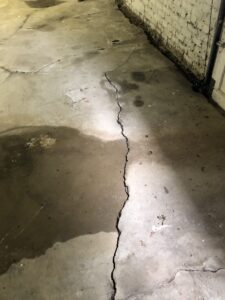Here are 5 Basement Waterproofing Tips every homeowner should know to not only stop the basement from flooding but improve indoor air quality. Many basements are damp and great sources of mold and other indoor pollutants. Molds and dust mites thrive in high humid environments. Bacteria, viruses, and wood rot fungus can also be found in wet basements. Structural problems like cracked concrete or bowing walls often frequent wet basements. We feel like there is more to basement waterproofing than just addressing the water.
Basement Waterproofing Tip #1 – Control Humidity
Let’s face it, basement waterproofing can be a major project. One of the easiest and most beneficial things to do is control humidity. This should be done in all parts of your home. Whether you are on a slab, basement, or crawl space; humidity levels affect the entire home. Even the attic can have high humidity levels.
Basement Dehumidifier
Make sure you install a great dehumidifier. The basement dehumidifier should be properly sized to your home and situation. If your basement is finished, it may need to be ducted. The dehumidifier can also be installed as part of the HVAC system. This is called a whole-home dehumidifier and takes the dry air to every room that is conditioned.
Does My Basement Need a Dehumidifier
https://crawlspaceninja.com/blog/does-my-basement-need-a-dehumidifier/
#2 – Fix Concrete Cracks in the Basement Floor
Concrete crack repair is our 2nd basement waterproofing tip and many times not even discussed. Concrete cracks can affect humidity and allow moisture intrusion. Keep in mind concrete crack repair is not the only way to stop water. It is however a viable solution to proper basement waterproofing. Concrete crack repair is recommended in basements, garages, driveways, sidewalks, and more. For you DIYers, check out Crack Fix.
#3 – Downspout Extensions
The downspouts of your home will dump a lot of water around your foundation. Many homes do not have proper downspout extensions installed. Even more don’t have them at all. Dumping the roof water directly next to your foundation will flood the basement, crawl space, and even slab homes. Downspout extensions can be run to minimize clogging. They should run into a catch basin and pop up emitter for best results. So downspout extensions are basement waterproofing tip #3.
Best Humidity Level for a Crawl Space or Basement
https://crawlspaceninja.com/blog/best-humidity-level-for-crawl-space/
#4 – Basement Floor Waterproofing Membrane Underlayment
This may be a new one for most of you. Basement waterproofers usually don’t cover the walls completely. Why would they install a basement floor underlayment membrane? Basement floor waterproofing membranes are a great way to protect your hardwood, tile, or other flooring options. Installed properly, it becomes an extension of the waterproofing system. Floor membranes can help control humidity and allow standing water to make its way back into the waterproofing trench and sump pump.
8 Tips All Sump Pump Owners Should Know
#5 – Basement Waterproofing The Walls
Homeowners hire us to install a basement waterproofing trench but not all choose to cover the entire wall. Hydrostatic pressure can build in basement walls and create humidity problems and even flood the basement. Make sure when you waterproof your basement you have a vapor barrier covering the entire basement wall. Using the Insul-barrier product will not only give the added moisture protection but insulate the basement as well.
Do you need help with your basement waterproofing project? If so, please contact Crawl Space Ninja and we will be glad to help. Also, let us know in the comments below if you’d like to suggest a future blog post.
Visit our DIY Store
Contact us if you need help fixing your crawl space, basement, attic, duct-work, foundation repair, or yard drainage by clicking here.
Learn about Crawl Space Ninja Franchise opportunity.


2 thoughts on “5 Basement Waterproofing Tips”
I am getting ready to do my 3 1/2 ‘tall crawl.Watched a lot of your videos and decided to hold off with the drylok paint.. I did already prep the surface with nuriatic acid.( not fun).I live in Northern ohio and have decided to try to stop the 600sq.ft. crawl from giving off a mildew odor. At one point I did get some mold growth on a couple floor joists. Cleaned it garbed in a suit and respirator.
Anyway my basement doesn’t have any trenches or sub-pump. The only reason that I did get mold was a clogged gutter one time many years back. I would just like to get this job done right once and for all. Cinder block isn’t painted and 3 sides are against dirt one is to an indoor space.Just use the space for storage. It does have a cement floor that previous owner had run a 2ft bevel of concrete up to the cinder block perimeter.Can I stop the smell of mildew with a vapor barrier without painting. Should I do both? Should I go for full encapsulation? Thanks Dan
Hi Daniel, if you are dealing with mainly a humidity issue and no standing water since fixing the downspout. I would install a dehumidifier and maybe a vapor barrier on the walls. The dehumidifier should keep the relative humidity under control (45 to 55%) without a vapor barrier but would run less often with plastic installed on walls. You can install plastic on the floor to help even more but then it could become slippery and create a potential trip hazard. We usually don’t install plastic over concrete floors because many times, depending on the age of the home, it was installed under the concrete. I would also consider insulating the walls with foamboard. Some foamboard can be vapor barriers too. If you install a foamboard that retards moisture you would not necessarily need vapor barrier. Hope that helps.